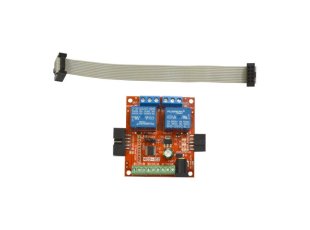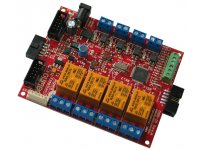≡




MOD-IO2




Input output expandable board with UEXT
| Price | 5.95 EUR |
|---|---|
| 10 - 49 pcs | 5.36 EUR |
| 50 - 10000 pcs | 4.76 EUR |
MOD-IO2 is a stackable development board which adds RELAYs and GPIOs to any of our development boards with UEXT. If you work with any of our development boards with a UEXT connector and you need more GPIOs and/or RELAY outputs, you can add these by connecting MOD-IO2 to your development board. This board gives you an easy way to interface up to 2 relays and 7 GPIOs. MOD-IO2 is stackable and addressable, what does this mean? It means that these boards can stack together so you can add as many inputs and outputs as you want! E.g. 2-4-6-8 etc.! MOD-IO2 has a PIC16F1503 microcontroller and the firmware is available for modification.
FEATURES
- PIC16F1503 microcontroller pre-loaded open-source firmware for easier interfacing, especially with Linux-enabled boards
- Uses I2C, allows I2C address change
- Stackable
- 9-pin terminal screw connector for 7 GPIOs, 3.3V and GND
- 7 GPIOs which could implement different functionality as PWM, SPI, I2C, ANALOG IN/OUT etc.
- 2 relay outputs with 15A/250VAC contacts with screw terminals
- RELAY output status LEDs
- UEXT male and female connectors
- PWR jack for 12V DC
- ICSP 6-pin connector for in-circuit programming and updating with PIC-KIT3 or other compatible programmer/debugger.
- Four mounting holes - 3.3mm ~ (0.13)"
- FR-4, 1.5mm ~ (0.062)", red soldermask, white silkscreen component print
- Dimensions: (61 x 52)mm ~ (2.40 x 2.05)"
DOCUMENTS
SOFTWARE
- MOD-IO2 firmware version 4.3
- Arduino IDE library and examples for MOD-IO2 and explanation how to use can be found here
- Linux tool for controlling MOD-IO2
- OLIMEXINO-STM32 and MOD-IO2 relay control
- Older firmware, older demo software, customer projects and more might be found at the wiki page: MOD-IO2 article
FAQ
- I found a very nice example of MOD-IO2 connected to another board in the internet. It doesn't work despite that I use the same setup as the author. What might be different?
- There are number of firmware revisions that had been released for MOD-IO2. You should ensure the example you have found used the same firmware revision of MOD-IO2 as the one you have on the module at the moment. Each major firmware revision might use a different board address (for firmware revisions 3, 3.1, 3.02, 4.3 it is the same - 0x21) AND DIFFERENT SET OF COMMANDS. Each firmware has a README file inside the source archive that is available for download. Refer to that README or the user's manual for more information about the firmware.



